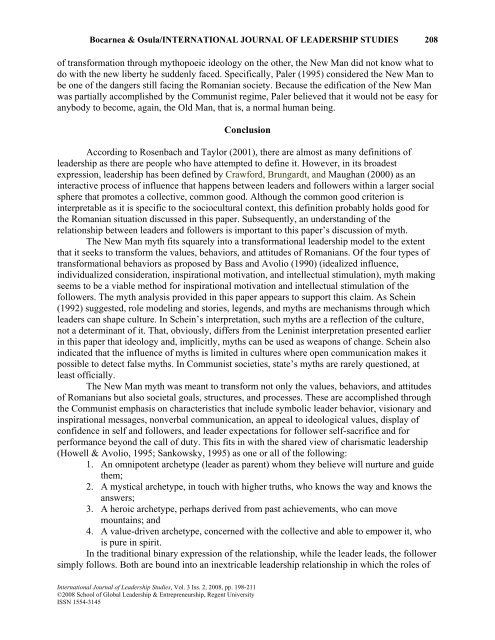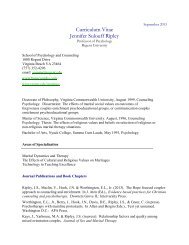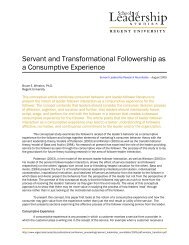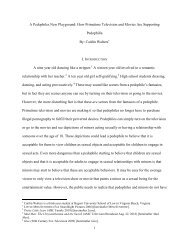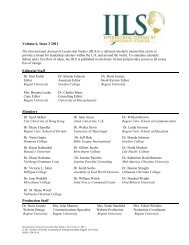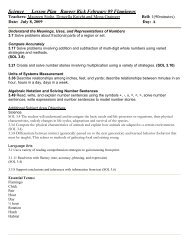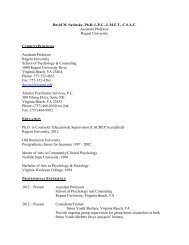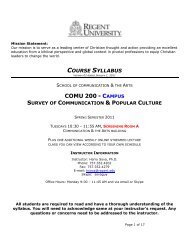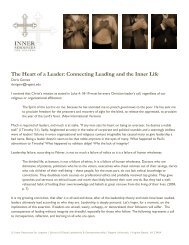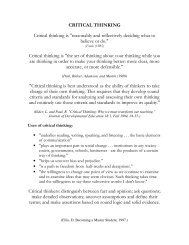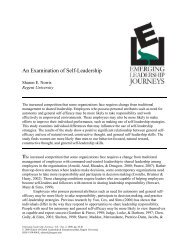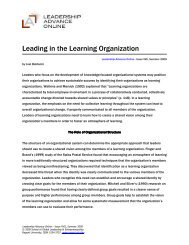Edifying the New Man: Romanian Communist ... - Regent University
Edifying the New Man: Romanian Communist ... - Regent University
Edifying the New Man: Romanian Communist ... - Regent University
You also want an ePaper? Increase the reach of your titles
YUMPU automatically turns print PDFs into web optimized ePapers that Google loves.
Bocarnea & Osula/INTERNATIONAL JOURNAL OF LEADERSHIP STUDIES 208<br />
of transformation through mythopoeic ideology on <strong>the</strong> o<strong>the</strong>r, <strong>the</strong> <strong>New</strong> <strong>Man</strong> did not know what to<br />
do with <strong>the</strong> new liberty he suddenly faced. Specifically, Paler (1995) considered <strong>the</strong> <strong>New</strong> <strong>Man</strong> to<br />
be one of <strong>the</strong> dangers still facing <strong>the</strong> <strong>Romanian</strong> society. Because <strong>the</strong> edification of <strong>the</strong> <strong>New</strong> <strong>Man</strong><br />
was partially accomplished by <strong>the</strong> <strong>Communist</strong> regime, Paler believed that it would not be easy for<br />
anybody to become, again, <strong>the</strong> Old <strong>Man</strong>, that is, a normal human being.<br />
Conclusion<br />
According to Rosenbach and Taylor (2001), <strong>the</strong>re are almost as many definitions of<br />
leadership as <strong>the</strong>re are people who have attempted to define it. However, in its broadest<br />
expression, leadership has been defined by Crawford, Brungardt, and Maughan (2000) as an<br />
interactive process of influence that happens between leaders and followers within a larger social<br />
sphere that promotes a collective, common good. Although <strong>the</strong> common good criterion is<br />
interpretable as it is specific to <strong>the</strong> sociocultural context, this definition probably holds good for<br />
<strong>the</strong> <strong>Romanian</strong> situation discussed in this paper. Subsequently, an understanding of <strong>the</strong><br />
relationship between leaders and followers is important to this paper’s discussion of myth.<br />
The <strong>New</strong> <strong>Man</strong> myth fits squarely into a transformational leadership model to <strong>the</strong> extent<br />
that it seeks to transform <strong>the</strong> values, behaviors, and attitudes of <strong>Romanian</strong>s. Of <strong>the</strong> four types of<br />
transformational behaviors as proposed by Bass and Avolio (1990) (idealized influence,<br />
individualized consideration, inspirational motivation, and intellectual stimulation), myth making<br />
seems to be a viable method for inspirational motivation and intellectual stimulation of <strong>the</strong><br />
followers. The myth analysis provided in this paper appears to support this claim. As Schein<br />
(1992) suggested, role modeling and stories, legends, and myths are mechanisms through which<br />
leaders can shape culture. In Schein’s interpretation, such myths are a reflection of <strong>the</strong> culture,<br />
not a determinant of it. That, obviously, differs from <strong>the</strong> Leninist interpretation presented earlier<br />
in this paper that ideology and, implicitly, myths can be used as weapons of change. Schein also<br />
indicated that <strong>the</strong> influence of myths is limited in cultures where open communication makes it<br />
possible to detect false myths. In <strong>Communist</strong> societies, state’s myths are rarely questioned, at<br />
least officially.<br />
The <strong>New</strong> <strong>Man</strong> myth was meant to transform not only <strong>the</strong> values, behaviors, and attitudes<br />
of <strong>Romanian</strong>s but also societal goals, structures, and processes. These are accomplished through<br />
<strong>the</strong> <strong>Communist</strong> emphasis on characteristics that include symbolic leader behavior, visionary and<br />
inspirational messages, nonverbal communication, an appeal to ideological values, display of<br />
confidence in self and followers, and leader expectations for follower self-sacrifice and for<br />
performance beyond <strong>the</strong> call of duty. This fits in with <strong>the</strong> shared view of charismatic leadership<br />
(Howell & Avolio, 1995; Sankowsky, 1995) as one or all of <strong>the</strong> following:<br />
1. An omnipotent archetype (leader as parent) whom <strong>the</strong>y believe will nurture and guide<br />
<strong>the</strong>m;<br />
2. A mystical archetype, in touch with higher truths, who knows <strong>the</strong> way and knows <strong>the</strong><br />
answers;<br />
3. A heroic archetype, perhaps derived from past achievements, who can move<br />
mountains; and<br />
4. A value-driven archetype, concerned with <strong>the</strong> collective and able to empower it, who<br />
is pure in spirit.<br />
In <strong>the</strong> traditional binary expression of <strong>the</strong> relationship, while <strong>the</strong> leader leads, <strong>the</strong> follower<br />
simply follows. Both are bound into an inextricable leadership relationship in which <strong>the</strong> roles of<br />
International Journal of Leadership Studies, Vol. 3 Iss. 2, 2008, pp. 198-211<br />
©2008 School of Global Leadership & Entrepreneurship, <strong>Regent</strong> <strong>University</strong><br />
ISSN 1554-3145


